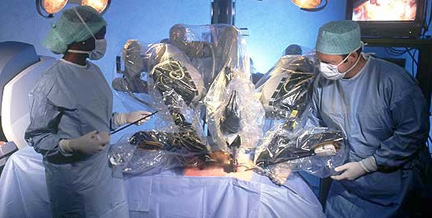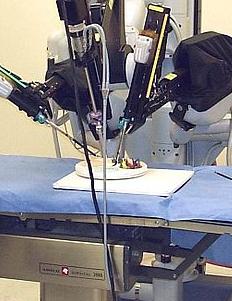- Home
- Surgical Robots
- Prosthetics
- Rehab
- Telepresence
- Pharmacy
- Other
- News
- Other
- Augmented Reality
- biopsy robots
- iwalk-powerfoot-biom
- Medical-Robotic-Arm
- micromedicine
- pillcam
- rehabilitation-robots
- robot-assisted-heart-surgeryrobot-assisted-heart-surgery
- robot-exoskeleton
- Robot Surgery Death
- robotic-arm-prosthesis
- robotic-assisted-brain-surgery
- robotic-surgery
- robotic-syringes
- robots-after-surgery
- robots-and-autism
- snakebots
- the-paro
- Man - Machine Interfaces
- Robot Nurse
Da Vinci Robotic Surgery
Da Vinci Robotic Surgery

Da Vinci Robotic Surgery. Certainly, the idea of having a robot cut through one’s flesh is terrifying, and I wonder just how trustingly I could be to place MY life into the hands of a doctor that is less than human, but on July of 2001, a cell tumor the size of an orange was successfully removed from Daniel Gutierrez's spine as his surgeon sat eight feet away, remotely manipulating tiny instruments that replicated the surgeon’s every hand and wrist movement. I am still in awe.
The surgeon was from the University of Southern California (USC) Keck School of Medicine, and Gutierrez became the first patient in the world to have a tumor removed from deep within his chest using Da Vinci robotic surgery. He apparently had absolutely nothing to be worried about: this robot’s ‘hands’ were steadier and more precise than any human’s.
Dr. Vaughn A. Starnes, founder of USC’s Robotic Surgery Institute explained that the robot can perform delicate movements that human surgeons normally cannot because unlike human hands, the during Da Vinci robot surgery, the robot can move within tiny, constricted spaces. Moreover, a superior technology built in the Da Vinci Robotic Surgery System is able transform a surgeon’s wrists, hands and fingers into precise, little instruments, rendering them actually more dexterous than that of a human’s.
With robots now buzzing in operating rooms around the country, advances made in the health care industry have been exponential, if not frenetic. The da Vinci prototype was developed in the late 1980’s under the U.S. Army, who wanted a technology that could enable doctors to perform remote, minimally invasive surgery off the battlefield. This was a technology that presented immense possibilities, and in 1995, the Intuitive Surgical Company was created to test the approach in a wider range of surgical procedures.
In 2000, the da Vinci Surgical System became the first robotic system cleared by the FDA to perform general laparoscopic surgery. This was followed with FDA clearings for thoracoscopic surgery, and some forms of cardiac, urologic and gynecologic procedures. Dr. Starnes, professor & chairman of the USC’s Department of Cardiothoracic Surgery, became one of the first surgeons to perform heart surgery using the remote controls of da Vinci. Together with his colleagues, Starnes continues to pioneer efforts to explore the numerous potentials and uses of robotic surgery, including finding ways to apply the technology in treating pulmonary diseases and other common thoracic problems.
Dr. da Vinci and the Da Vinci Robotic Surgery System seem like they are here to stay.
Cick HERE to learn about the Da Vinci Robotic Surgery Company

Today, the da Vinci robot can perform minimally invasive surgery for a number of complex surgical procedures, including gynecologic, urologic (including prostate cancer surgery), abdominal, chest and robot heart surgery. Major surgery can be done through the smallest of incisions, eliminating the need to cut through layers of muscle and significantly reducing the patients’ pain, blood loss and possible side effects.
But as with all imaginably daunting things, robotic surgery has its share of critics. Procedures, which are not normally covered by insurance, are pricey, costing up to $15,000 per operation. It has not been extensively tested nor have comprehensive, long-term studies on the technology been established, so in the hands of careless surgeons, this procedure can be very dangerous. And then there’s that question of how much you can trust a surgeon probing your navel from 8 feet away.
I’d have to say the bigger question is how one cannot. The da Vinci has proven itself quite the cunning little machine, and ultimately, judgment still lies in the surgeon. While it is technically the surgical robot doing the probing and inserting, it is the surgeon’s hands and skills orchestrating the entire thing—just as the great painter da Vinci directed his brushes with his strokes. In the end, the surgeon is still master, and the robot is his tool. And in this case, one extremely remarkable and amazing tool.
As for patients like Gutierrez and the many others who are now leading lives free from fear and pain all thanks to the robot da Vinci, I’m sure they’d agree. It is my opinion that the astounding wonders of robotic surgery will continue and will completely revolutionize the medical world.
Recent Articles
-
Robot Nurse Cody
Aug 27, 16 12:58 AM
Robot Nurse Cody is is nurse who... -
The Neural Interface System
Aug 26, 16 09:31 PM
The BrainGate Neural Interface System is helping people who suffer from paralysis to cope. -
The Paro - Non-Surgical Animal Robot Helps Dementia Patients
Aug 26, 16 09:28 PM
The Paro, a non-surgical animal robot, helps aid patients with dementia.
